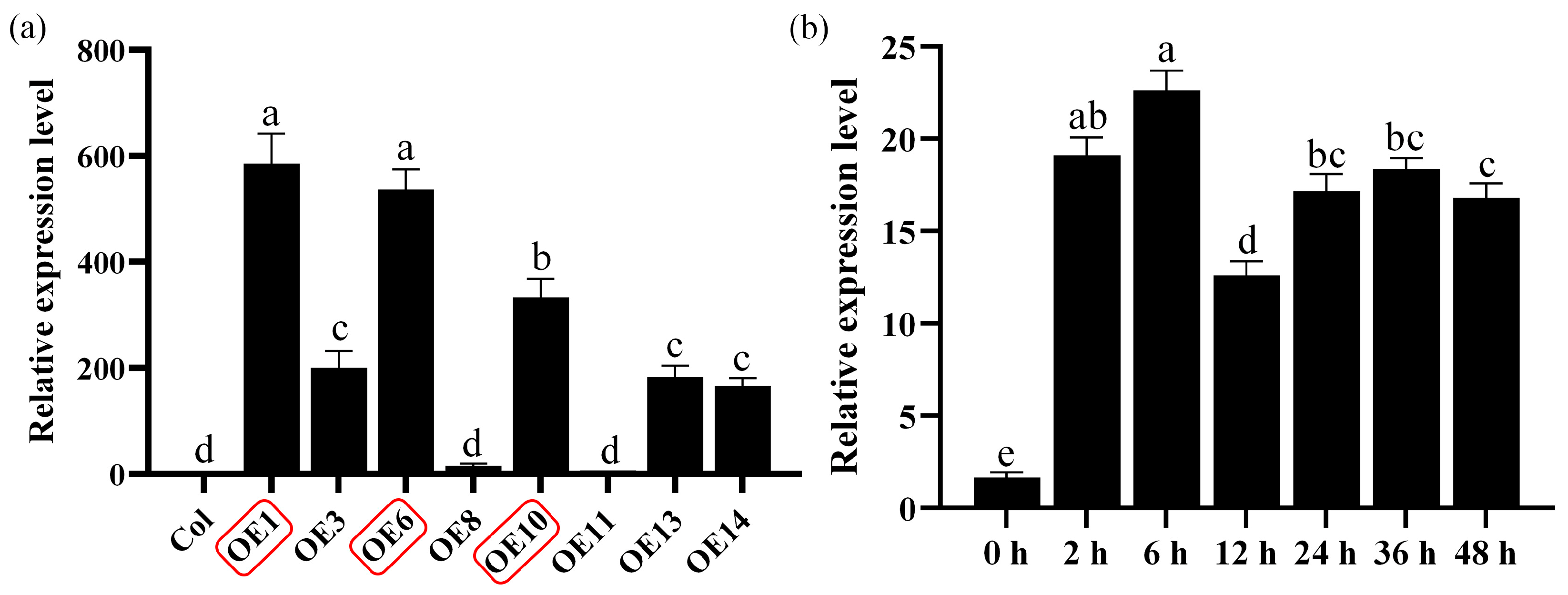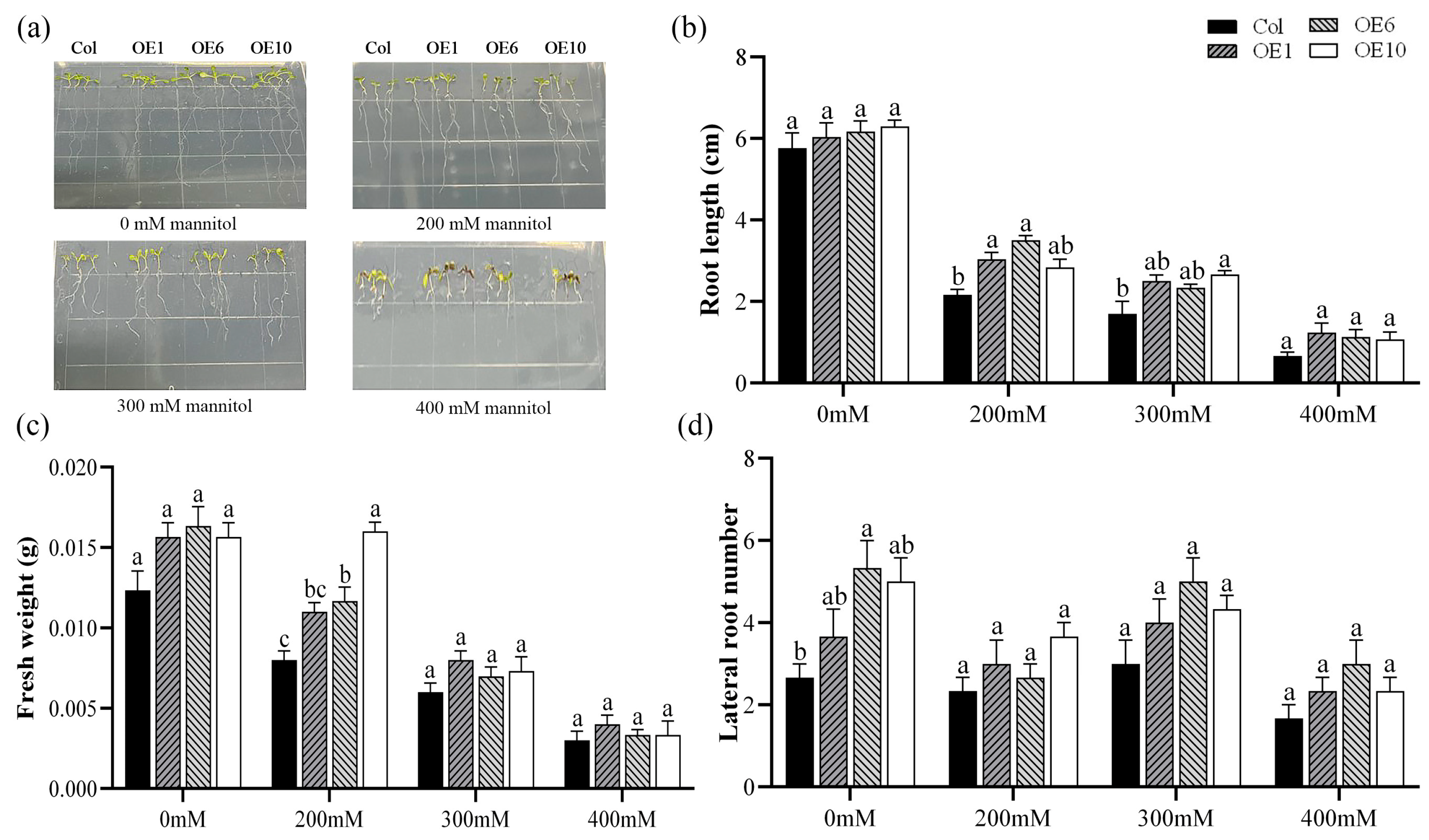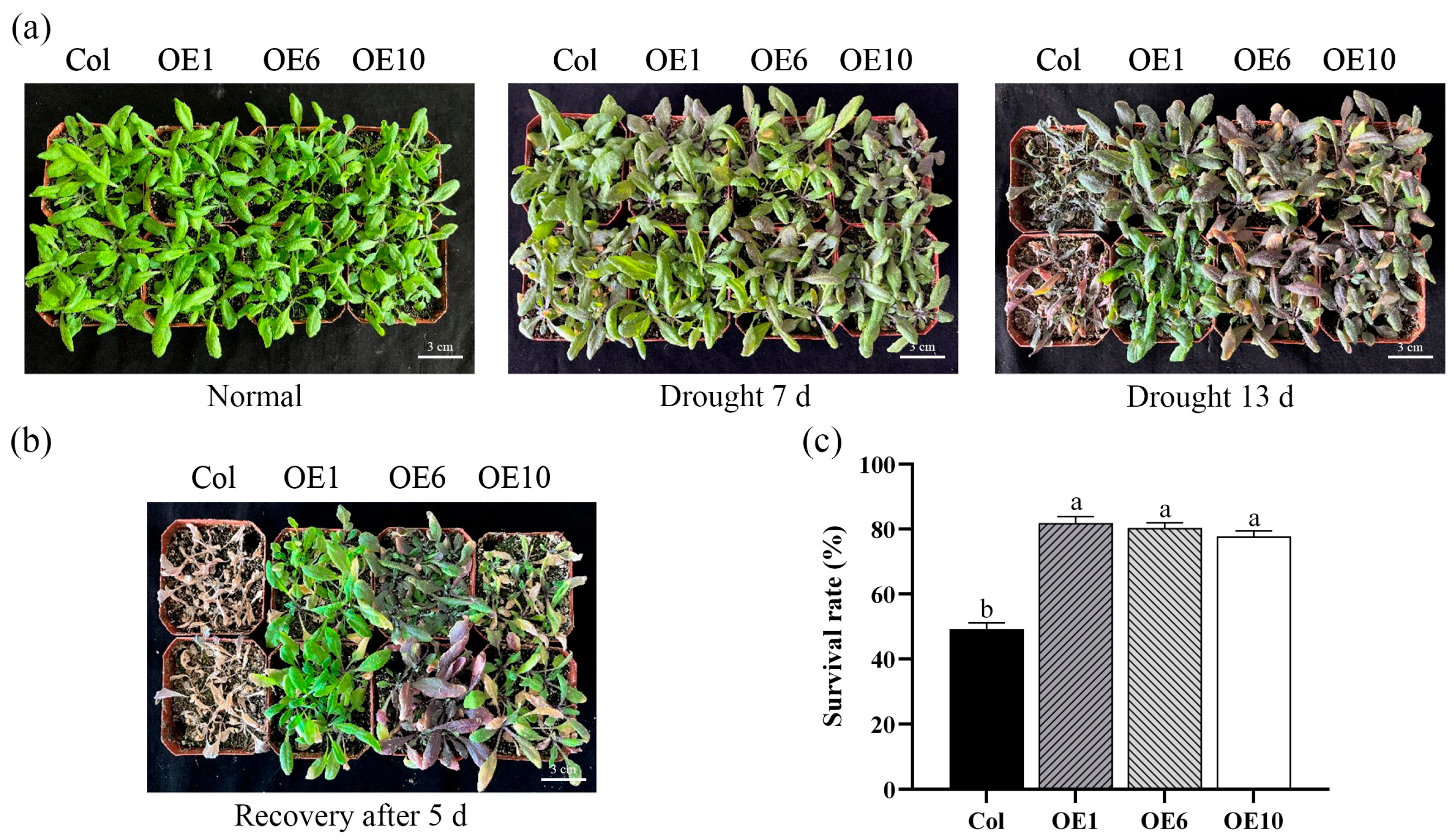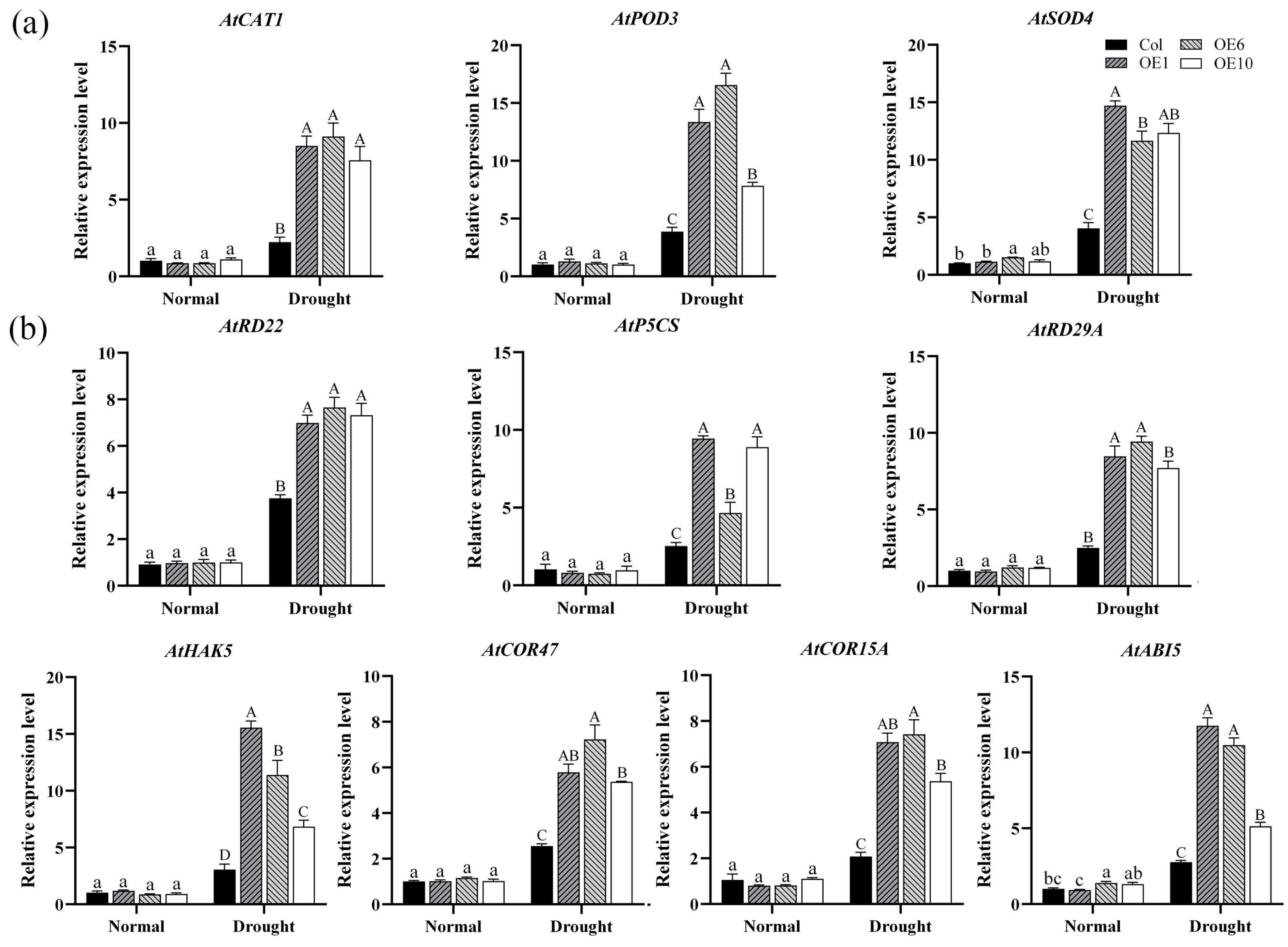MfWRKY40 Positively Regulates Drought Tolerance in Arabidopsis thaliana by Scavenging Reactive Oxygen Species
Abstract
1. Introduction
2. Results
2.1. Generation of Transgenic A. thaliana Overexpressing MfWRKY40
2.2. Response of the Transgenic A. thaliana to Mannitol Treatment
2.3. Response of the MfWRKY40 Gene to ABA
2.4. Phenotypic Analysis of Transgenic A. thaliana
2.5. MfWRKY40 Reduces Water Loss in Transgenic A. thaliana
2.6. Effects of MfWRKY40 on Physiological Indicators
2.7. Regulation of Enzymes and Drought-Related Genes by MfWRKY40
3. Discussion
4. Materials and Methods
4.1. Plant Materials
4.2. Cloning of the MfWRKY40 Gene and Construction of the Overexpression Vector
4.3. Generation of Transgenic A. thaliana
4.4. RNA Extraction and Quantitative Real-Time PCR (qRT-PCR)
4.5. Stress Treatment of Transgenic A. thaliana
4.6. Determination of Water Loss Rate and Fresh/Dry Weight
4.7. NBT Staining and Determination of Physiological Indices
4.8. Data Analysis
5. Conclusions
Supplementary Materials
Author Contributions
Funding
Institutional Review Board Statement
Informed Consent Statement
Data Availability Statement
Acknowledgments
Conflicts of Interest
References
- Chinnusamy, V.; Zhu, J.; Zhu, J.K. Salt Stress Signaling and Mechanisms of Plant Salt Tolerance. Genet. Eng. 2006, 27, 141–177. [Google Scholar]
- Liu, W.; Wei, J.W.; Shan, Q.; Liu, M.; Xu, J.; Gong, B. Genetic Engineering of Drought-and Salt-Tolerant Tomato via Δ1-Pyrroline-5-Carboxylate Reductase S-Nitrosylation. Plant Physiol. 2024, 195, 1038–1052. [Google Scholar] [CrossRef]
- Yang, R.; Sun, Y.; Zhao, Y.; Bai, C.; Liu, Y.; Sun, J.; Wang, Z.; Yuan, F.; Wang, X.; Liu, W.; et al. Overexpression of MtNAC33 Enhances Biomass Yield and Drought Tolerance in Alfalfa. Plant Biotechnol. J. 2025, 23, 1452–1454. [Google Scholar] [CrossRef]
- Apel, K.; Hirt, H. Reactive Oxygen Species: Metabolism, Oxidative Stress, and Signal Transduction. Annu. Rev. Plant Biol. 2004, 55, 373–399. [Google Scholar] [CrossRef]
- Zhou, X.; Sun, Z.; Huang, Y.; He, D.; Lu, L.; Wei, M.; Lin, S.; Luo, W.; Liao, X.; Jin, S.; et al. WRKY45 Positively Regulates Salinity and Osmotic Stress Responses in Arabidopsis. Plant Physiol. Biochem. 2025, 219, 109408. [Google Scholar] [CrossRef]
- Ahmad, M.; Alabd, A.; Gao, Y.; Yu, W.; Jamil, W.; Wang, X.; Wei, J.; Ni, J.; Teng, Y.; Bai, S. Three Stress-Responsive NAC Transcription Factors, Pp-SNACs, Differentially and Synergistically Regulate Abiotic Stress in Pear. Sci. Hortic. 2022, 305, 111393. [Google Scholar] [CrossRef]
- Aslam, M.; Fakher, B.; Ashraf, M.A.; Cheng, Y.; Wang, B.; Qin, Y. Plant Low-Temperature Stress: Signaling and Response. Agronomy 2022, 12, 702. [Google Scholar] [CrossRef]
- Wang, Y.; He, W.; Wang, L.; Lan, Y.; Wu, M. TCP Transcription Factor Identification in Pecan (Carya illinoensis) and Salt Tolerance Function Analysis of CiTCP8. Sci. Hortic. 2024, 330, 113051. [Google Scholar] [CrossRef]
- Chen, J.; Nolan, T.M.; Ye, H.; Zhang, M.; Tong, H.; Xin, P.; Chu, J.; Chu, C.; Li, Z.; Yin, Y. Arabidopsis WRKY46, WRKY54, and WRKY70 Transcription Factors Are Involved in Brassinosteroid-Regulated Plant Growth and Drought Responses. Plant cell 2017, 29, 1425–1439. [Google Scholar] [CrossRef]
- Li, W.; Li, P.; Chen, H.; Zhong, J.; Liang, X.; Wei, Y.; Zhang, L.; Wang, H.; Han, D. Overexpression of a Fragaria vesca 1R-MYB Transcription Factor Gene (FvMYB114) Increases Salt and Cold Tolerance in Arabidopsis thaliana. Int. J. Mol. Sci. 2023, 24, 5261. [Google Scholar] [CrossRef] [PubMed]
- Li, W.; Wei, Y.; Zhang, L.; Wang, Y.; Song, P.; Li, X.; Han, D. FvMYB44, a Strawberry R2R3-MYB Transcription Factor, Improved Salt and Cold Stress Tolerance in Transgenic Arabidopsis. Agronomy 2023, 13, 1051. [Google Scholar] [CrossRef]
- Li, B.; Wang, X.; Wang, X.; Xi, Z. An AP2/ERF Transcription Factor VvERF63 Positively Regulates Cold Tolerance in Arabidopsis and Grape Leaves. Environ. Exp. Bot. 2023, 205, 105124. [Google Scholar] [CrossRef]
- Liu, W.; Wang, T.; Liang, X.; Ye, Q.; Wang, Y.; Han, J.; Han, D. MbWRKY53, a M. baccata WRKY Transcription Factor, Contributes to Cold and Drought Stress Tolerance in Transgenic Arabidopsis thaliana. Int. J. Mol. Sci. 2024, 25, 7626. [Google Scholar] [CrossRef] [PubMed]
- Wang, H.; Cheng, X.; Yin, D.; Chen, D.; Luo, C.; Liu, H.; Huang, C. Advances in the Research on Plant WRKY Transcription Factors Responsive to External Stresses. Curr. Issues Mol. Biol. 2023, 45, 2861–2880. [Google Scholar] [CrossRef]
- Ma, Z.; Hu, L. WRKY Transcription Factor Responses and Tolerance to Abiotic Stresses in Plants. Int. J. Mol. Sci. 2024, 25, 6845. [Google Scholar] [CrossRef]
- Glöckner, G.; Eichinger, L.; Szafranski, K.; Pachebat, J.A.; Bankier, A.T.; Dear, P.H.; Lehmann, R.; Baumgart, C.; Parra, G.; Abril, J.F.; et al. Sequence and Analysis of Chromosome 2 of Dictyostelium discoideum. Nature 2002, 418, 79–85. [Google Scholar] [CrossRef]
- Zhang, X.; Zhang, Y.; Li, M.; Jia, H.; Wei, F.; Xia, Z.; Zhang, X.; Chang, J.; Wang, Z. Overexpression of The WRKY Transcription Factor Gene NtWRKY65 Enhances Salt Tolerance in Tobacco (Nicotiana tabacum). BMC Plant Biol. 2024, 24, 326. [Google Scholar] [CrossRef]
- Zheng, Y.; Ge, J.; Bao, C.; Chang, W.; Liu, J.; Shao, J.; Liu, X.; Su, L.; Pan, L.; Zhou, D.X. Histone Deacetylase HDA9 and WRKY53 Transcription Factor Are Mutual Antagonists in Regulation of Plant Stress Response. Mol. Plant 2020, 13, 598–611. [Google Scholar] [CrossRef] [PubMed]
- Lv, B.; Wu, Q.; Wang, A.; Li, Q.; Dong, Q.; Yang, J.; Zhao, H.; Wang, X.; Chen, H.; Li, C.A. WRKY Transcription Factor, FtWRKY46, From Tartary buckwheat Improves Salt Tolerance in Transgenic Arabidopsis thaliana. Plant Physiol. Biochem. 2020, 147, 43–53. [Google Scholar] [CrossRef]
- Liu, Z.; Wang, P.; Wang, Z.; Wang, C.; Wang, Y. Birch WRKY Transcription Factor, BpWRKY32, Confers Salt Tolerance by Mediating Stomatal Closing, Proline Accumulation, and Reactive Oxygen Species Scavenging. Plant Physiol. Biochem. 2024, 210, 108599. [Google Scholar] [CrossRef]
- Zhou, W.; Yang, S.; Yang, L.; Xiao, R.; Chen, S.; Wang, D.; Wang, S.; Wang, Z. Genome-Wide Identification of the Hypericum perforatum WRKY Gene Family Implicates HpWRKY85 in Drought Resistance. Int. J. Mol. Sci. 2022, 24, 352. [Google Scholar] [CrossRef]
- Bao, Y.; Zou, Y.; An, X.; Liao, Y.; Dai, L.; Liu, L.; Peng, D.; Huang, X.; Wang, B. Overexpression of a Ramie (Boehmaeria nivea L. Gaud) Group I WRKY Gene, BnWRKY49, Increases Drought Resistance in Arabidopsis thaliana. Plants 2024, 13, 379. [Google Scholar] [CrossRef]
- Duan, D.; Yi, R.; Ma, Y.; Dong, Q.; Mao, K.; Ma, F. Apple WRKY Transcription Factor MdWRKY56 Positively Modulates Drought Stress Tolerance. Environ. Exp. Bot. 2023, 212, 105400. [Google Scholar] [CrossRef]
- Li, W.; Li, D.; Li, H.; Wang, M.; Wang, Z.; Liu, J. The Tomato WRKY Transcription Factor SlWRKY17 Positively Regulates Drought Stress Tolerance in Transgenic Tobacco Plants. Russ. J. Plant Physiol. 2023, 69, 154. [Google Scholar] [CrossRef]
- Ahkami, A.H.; Wang, W.; Wietsma, T.W.; Winkler, T.; Lange, I.; Jansson, C.; Lange, M.; McDowell, N.G. Metabolic Shifts Associated with Drought-Induced Senescence in Brachypodium. Plant Sci. 2019, 289, 110278. [Google Scholar] [CrossRef]
- Duan, M.; Zhang, R.; Zhu, F.; Zhang, Z.; Gou, L.; Wen, J.; Dong, J.; Wang, T. A Lipid-Anchored NAC Transcription Factor Is Translocated into the Nucleus and Activates Glyoxalase I Expression during Drought Stress. Plant cell 2017, 29, 1748. [Google Scholar] [CrossRef]
- Vyšniauskienė, R.; Naugžemys, D.; Patamsytė, J.; Rančelienė, V.; Čėsnienė, T.; Žvingila, D. ISSR and Chloroplast DNA Analyses Indicate Frequent Hybridization of Alien Medicago sativa subsp. sativa and Native M. sativa subsp. falcata. Plant Syst. Evol. 2015, 301, 2341–2350. [Google Scholar] [CrossRef]
- Jiang, Z. Cloning and Functional Analysis of the MfWRKY40 Gene in Medicago falcata L. Master’s Thesis, Xinjiang Agricultural University, Urumqi, China, 2024. [Google Scholar]
- Javed, T.; Gao, S.J. WRKY Transcription Factors in Plant Defense. Trends Genet. 2023, 39, 787–801. [Google Scholar] [CrossRef] [PubMed]
- Hou, X.; Ma, C.; Wang, Z.; Shi, X.; Duan, W.; Fu, X.; Liu, J.; Guo, C.; Xiao, K. Transcription Factor Gene TaWRKY76 Confers Plants Improved Drought and Salt Tolerance Through Modulating Stress Defensive-Associated Processes in Triticum aestivum L. Plant Physiol. Biochem. 2024, 216, 109147. [Google Scholar] [CrossRef]
- Gao, H.; Wang, Y.; Xu, P.; Zhang, Z. Overexpression of a WRKY Transcription Factor TaWRKY2 Enhances Drought Stress Tolerance in Transgenic wheat. Front. Plant Sci. 2018, 9, 997. [Google Scholar] [CrossRef] [PubMed]
- Yu, Y.; He, L.; Wu, Y. Wheat WRKY Transcription Factor TaWRKY24 Confers Drought and Salt Tolerance in Transgenic Plants. Plant Physiol. Biochem. 2023, 205, 108137. [Google Scholar] [CrossRef]
- Lv, M.; Hou, D.; Wan, J.; Ye, T.; Zhang, L.; Fan, J.; Li, C.; Dong, Y.; Chen, W.; Rong, S.; et al. OsWRKY97, an Abiotic Stress-Induced Gene of Rice, Plays a Key Role in Drought Tolerance. Plants 2023, 12, 3338. [Google Scholar] [CrossRef]
- Fei, J.; Liu, Z.; Wang, P.; Qu, J.; Liu, S.; Guan, S.; Ma, Y. The Maize WRKY Transcription Factor ZmWRKY25 Respond Drought Stress in Transgenic Tobacco. Phyton-Int. J. Exp. Bot. 2024, 93, 3617–3635. [Google Scholar]
- Gu, L.; Chen, X.; Hou, Y.; Cao, Y.; Wang, H.; Zhu, B.; Du, X.; Wang, H. ZmWRKY30 Modulates Drought Tolerance in Maize by Influencing myo-Inositol and Rreactive Oxygen Species Homeostasis. Physiol. Plant. 2024, 176, e14423. [Google Scholar] [CrossRef] [PubMed]
- Wen, W.; Wang, R.; Su, L.; Lv, A.; Zhou, P.; An, Y. MsWRKY11, Activated by MsWRKY22, Functions in Drought Tolerance and Modulates Lignin Biosynthesis in Alfalfa (Medicago sativa L.). Environ. Exp. Bot. 2021, 184, 104373. [Google Scholar] [CrossRef]
- Liu, J.; Wang, X.; Ma, L.; Cui, M.; Cai, X.; Zhao, W. Isolation and Characterization of MsWRKY42 From Alfalfa (Medicago sativa) and Its Response to Abiotic Stresses. Sci. Agric. Sin. 2020, 53, 3455–3466. [Google Scholar]
- Zhang, J.; Huang, D.; Zhao, X.; Zhang, M.; Wang, Q.; Hou, X.; Di, D.; Su, B.; Wang, S.; Sun, P. Drought-Responsive WRKY transcription factor genes IgWRKY50 and IgWRKY32 from Iris germanica Enhance Drought Resistance in Transgenic Arabidopsis. Front. Plant Sci. 2022, 13, 983600. [Google Scholar] [CrossRef]
- Li, X.; Tang, Y.; Zhou, C.; Zhang, L.; Lv, J. A Wheat WRKY Transcription Factor TaWRKY46 Enhances Tolerance to Osmotic Stress in Transgenic Arabidopsis Plants. Int. J. Mol. Sci. 2020, 21, 1321. [Google Scholar] [CrossRef] [PubMed]
- Lorens, G.F.; Bennett, J.M.; Loggale, L.B. Differences in Drought Resistance between Two Corn Hybrids. I. Water Relations and Root Length Density 1. Agron. J. 1987, 79, 802–807. [Google Scholar] [CrossRef]
- Ekanayake, I.J.; O’Toole, J.C.; Garrity, D.P.; Masajo, T.M. Inheritance of Root Characters and their Relations to Drought Resistance in Rice 1. Crop Sci. 1985, 25, 927–933. [Google Scholar] [CrossRef]
- Reicosky, D.C.; Deaton, D.E. Soybean Water Extraction, Leaf Water Potential, and Evapotranspiration during Drought 1. Agron. J. 1979, 71, 45–50. [Google Scholar] [CrossRef]
- Verslues, P.E.; Agarwal, M.; Katiyar-Agarwal, S.; Zhu, J.; Zhu, J.K. Methods and Concepts in Quantifying Resistance to Drought, Salt and Freezing, Abiotic Stresses That Affect Plant Water Status. Plant J. 2006, 45, 523–539. [Google Scholar] [CrossRef]
- Foyer, C.H.; Noctor, G. Tansley Review No. 112. Oxygen Processing in Photosynthesis: Regulation and Signalling. New Phytol. 2000, 146, 359–388. [Google Scholar] [CrossRef]
- Kumar, A.; Prasad, A.; Sedlářová, M.; Pospíšil, P. Malondialdehyde Enhances PsbP Protein Release during Heat Stress in Arabidopsis. Plant Physiol. Biochem. 2023, 202, 107984. [Google Scholar] [CrossRef] [PubMed]
- Guo, J.; Zhao, Y.; Yang, Y.; Guan, Q. Roles of Superoxide Dismutase in Plant Response to Drought, Salinity and Cold Stress. J. Plant Res. 2024, 44, 481–491. [Google Scholar]
- Yadav, S.; Gill, S.S.; Passricha, N.; Gill, R.; Badhwar, P.; Anjum, N.A.; Francisco, J.B.J.; Tuteja, N. Genome-Wide Analysis and Transcriptional Expression Pattern-Assessment of Superoxide Dismutase (SOD) in Rice and Arabidopsis under Abiotic Stresses. Plant Gene 2019, 17, 100165. [Google Scholar] [CrossRef]
- Ampofo, J.O.; Ngadi, M. Stimulation of the Phenylpropanoid Pathway and Antioxidant Capacities by Biotic and Abiotic Elicitation Strategies in Common Bean (Phaseolus vulgaris) Sprouts. Process Biochem. 2021, 100, 98–106. [Google Scholar] [CrossRef]
- Zhong, M.; Song, R.; Wang, Y.; Shu, S.; Sun, J.; Guo, S. TGase Regulates Salt Stress Tolerance through Enhancing Bound Polyamines Mediated Antioxidant Enzymes Activity in Tomato. Environ. Exp. Bot. 2020, 179, 104191. [Google Scholar] [CrossRef]
- Sun, S.; Li, X.; Gao, S.; Nie, N.; Zhang, H.; Yang, Y.; He, S.; Liu, Q.; Zhai, H. A Novel WRKY Transcription Factor from Ipomoea trifida, ItfWRKY70, Confers Drought Tolerance in Sweet Potato. Int. J. Mol. Sci. 2022, 23, 686. [Google Scholar] [CrossRef]
- Gao, Y.; Liu, J.; Yang, F.; Zhang, G.; Wang, D.; Zhang, L.; Ou, Y.; Yao, Y. The WRKY Transcription Factor WRKY8 Promotes Resistance to Pathogen Infection and Mediates Drought and Salt Stress Tolerance in Solanum lycopersicum. Physiol. Plant. 2020, 168, 98–117. [Google Scholar] [CrossRef] [PubMed]
- Akram, W.; Yasin, N.A.; Shah, A.A.; Khan, W.U.; Li, G.; Ahmad, A.; Ahmed, S.; Hussaan, M.; Rizwan, M.; Ali, S. Exogenous Application of Liquiritin Alleviated Salt Stress and Improved Growth of Chinese Kale Plants. Sci. Hortic. 2022, 294, 110762. [Google Scholar] [CrossRef]
- Han, J.; Li, X.; Li, W.; Yao, A.; Niu, C.; Hou, R.; Liu, W.; Wang, Y.; Zhang, L.; Han, D. Overexpression of Malus baccata WRKY40 (MbWRKY40) Enhances Stress Tolerance in Arabidopsis Subjected to Cold and Drought. Plant Stress 2023, 10, 100209. [Google Scholar] [CrossRef]
- Narusaka, Y.; Nakashima, K.; Shinwari, Z.K.; Sakuma, Y.; Furihata, T.; Abe, H.; Narusaka, M.; Shinozaki, K.; Yamaguchi-Shinozaki, K. Interaction between Two cis-Acting Elements, ABRE and DRE, in ABA-dependent Expression of Arabidopsis rd29A Gene in Response to Dehydration and High-Salinity Stresses. Plant J. 2003, 34, 137–148. [Google Scholar] [CrossRef]
- Wu, M.; Zhang, K.; Xu, Y.; Wang, L.; Liu, H.; Qin, Z.; Xiang, Y. The Moso Bamboo WRKY Transcription Factor, PheWRKY86, Regulates Drought Tolerance in Transgenic Plants. Plant Physiol. Biochem. 2022, 170, 180–191. [Google Scholar] [CrossRef]
- Karimi, M.; Inzé, D.; Depicker, A. GATEWAYTM Vectors for Agrobacterium-Mediated Plant Transformation. Trends Plant Sci. 2002, 7, 193–195. [Google Scholar] [CrossRef]
- Clough, S.J.; Bent, A.F. Floral Dip: A Simplified Method for Agrobacterium-Mediated Transformation of Arabidopsis thaliana. Plant J. 1998, 16, 735–743. [Google Scholar] [CrossRef]
- Shimada, T.L.; Shimada, T.; Hara-Nishimura, I. A Rapid and Non-Destructive Screenable Marker, FAST, for Identifying Transformed Seeds of Arabidopsis thaliana. Plant J. 2010, 61, 519–528. [Google Scholar] [CrossRef]
- Wang, X.; Gao, M.; Kong, Y.; Yu, Q.; Yao, L.; Li, X.; Li, W.; Liu, W.; Hou, R.; Zhang, L. Overexpression of a Malus baccata (L.) Borkh WRKY Factor Gene MbWRKY33 Increased High Salinity Stress Tolerance in Arabidopsis thaliana. Int. J. Mol. Sci. 2025, 26, 5833. [Google Scholar] [CrossRef]
- Livak, K.J.; Schmittgen, T.D. Analysis of Relative Gene Expression Data Using Real-Time Quantitative PCR and the 2−∆∆CT Method. Methods 2001, 25, 402–408. [Google Scholar] [CrossRef]
- Mei, F.; Chen, B.; Li, F.; Zhang, Y.; Kang, Z.; Wang, X.; Mao, H. Overexpression of the Wheat NAC Transcription Factor TaSNAC4-3A Gene Confers Drought Tolerance in Transgenic Arabidopsis. Plant Physiol. Biochem. 2021, 160, 37–50. [Google Scholar] [CrossRef]








Disclaimer/Publisher’s Note: The statements, opinions and data contained in all publications are solely those of the individual author(s) and contributor(s) and not of MDPI and/or the editor(s). MDPI and/or the editor(s) disclaim responsibility for any injury to people or property resulting from any ideas, methods, instructions or products referred to in the content. |
© 2025 by the authors. Licensee MDPI, Basel, Switzerland. This article is an open access article distributed under the terms and conditions of the Creative Commons Attribution (CC BY) license (https://creativecommons.org/licenses/by/4.0/).
Share and Cite
Zhang, X.; Duan, W.; Wang, Y.; Jiang, Z.; Li, Q. MfWRKY40 Positively Regulates Drought Tolerance in Arabidopsis thaliana by Scavenging Reactive Oxygen Species. Int. J. Mol. Sci. 2025, 26, 8495. https://doi.org/10.3390/ijms26178495
Zhang X, Duan W, Wang Y, Jiang Z, Li Q. MfWRKY40 Positively Regulates Drought Tolerance in Arabidopsis thaliana by Scavenging Reactive Oxygen Species. International Journal of Molecular Sciences. 2025; 26(17):8495. https://doi.org/10.3390/ijms26178495
Chicago/Turabian StyleZhang, Xueli, Wei Duan, Yuxiang Wang, Zhihu Jiang, and Qian Li. 2025. "MfWRKY40 Positively Regulates Drought Tolerance in Arabidopsis thaliana by Scavenging Reactive Oxygen Species" International Journal of Molecular Sciences 26, no. 17: 8495. https://doi.org/10.3390/ijms26178495
APA StyleZhang, X., Duan, W., Wang, Y., Jiang, Z., & Li, Q. (2025). MfWRKY40 Positively Regulates Drought Tolerance in Arabidopsis thaliana by Scavenging Reactive Oxygen Species. International Journal of Molecular Sciences, 26(17), 8495. https://doi.org/10.3390/ijms26178495




